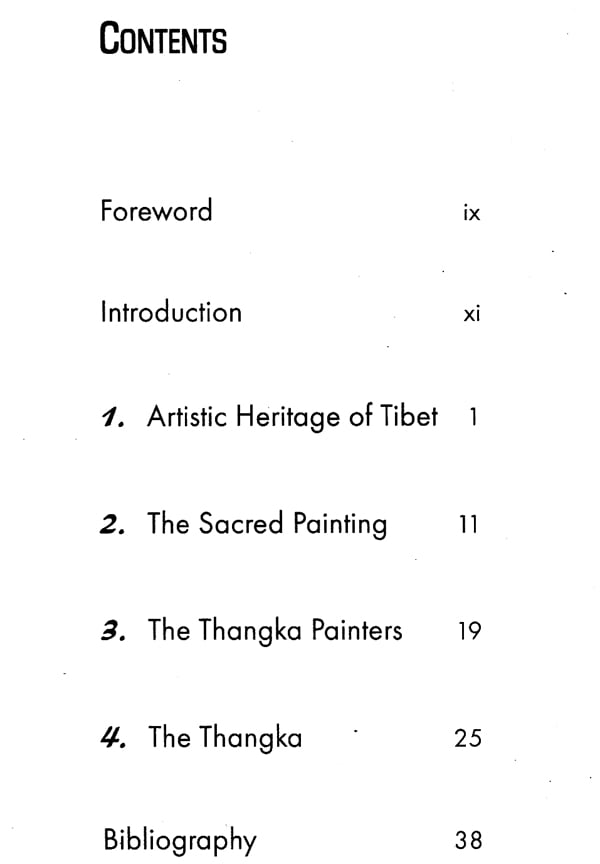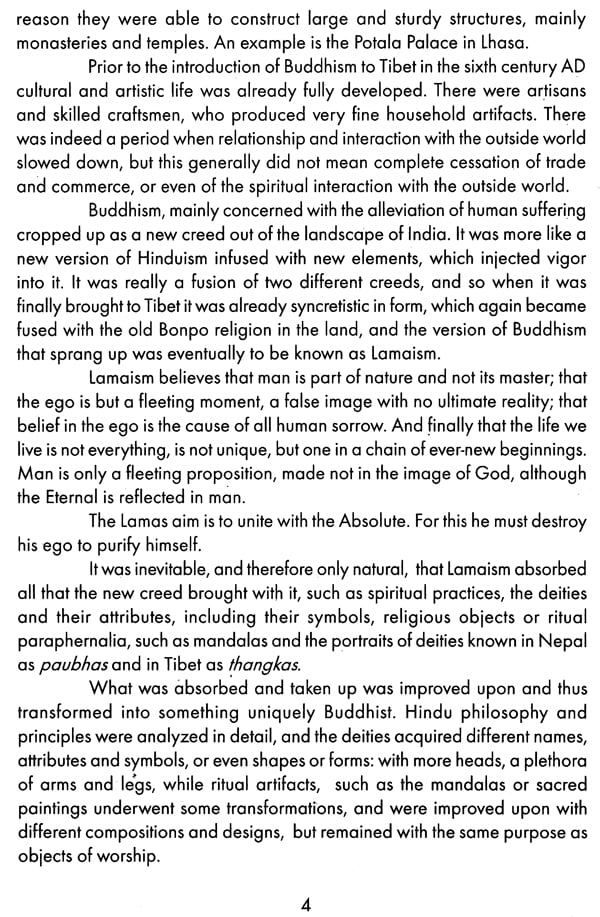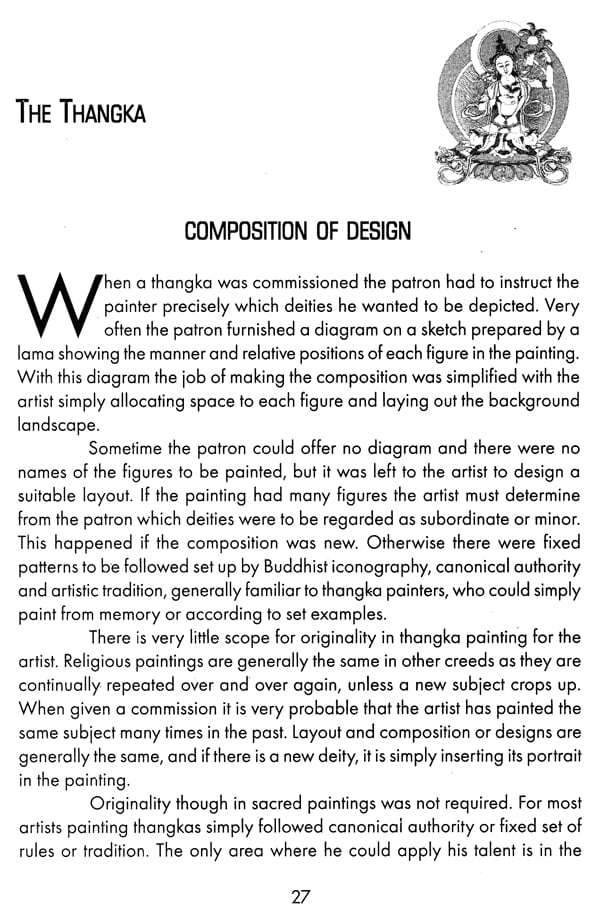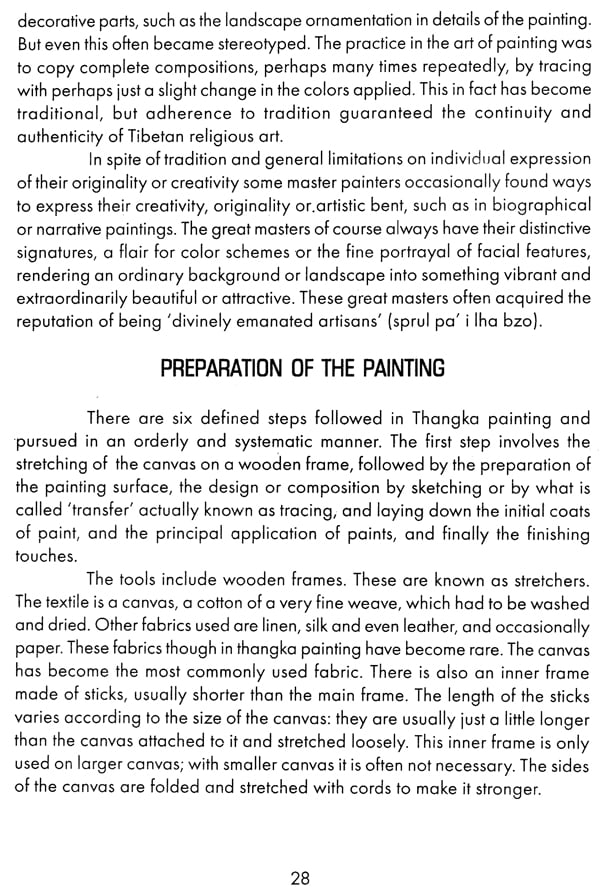
Thangka- The Sacred Painting of Tibet
Book Specification
| Item Code: | NAY214 |
| Author: | J.R. Santiago |
| Publisher: | Book Faith India |
| Language: | English |
| Edition: | 1999 |
| ISBN: | 9788173031861 |
| Pages: | 49 |
| Cover: | PAPERBACK |
| Other Details | 7.00 X 5.00 inch |
| Weight | 60 gm |
Book Description
The Buddha in a meditative pose is the symbol of perfection. It represents a man who has attained enlightenment and Nirvana. It exudes and evokes gentleness and a quietude that is profound and therefore solemn and sacred. There has been probably a time when Buddhism produced a perfect society, a utopia, based on the Four Noble Truths, the Eightfold Path and the Three Jewels: the Buddha, Dharma and the Sangha.
And this is mainly because it is a creed that is structured: people are not left to themselves, but are guided. Besides the Eightfold Path it also forbids evil thoughts, words and deeds. With the principal doctrine of compassion for all sentient beings it forbids doing evil to others, but suggests the cultivation and nourishment of virtues to gain merit not only in this earthly life, but in the hereafter.
This short overview on thangka was supposed to be on the sacred paintings of Buddhism in general. However, there are very few Buddhist paintings left or available, and what predominates the market and have been turned into commercial articles are the Tibetan thangkas, which undoubtedly have become popular on account of the Lamaist version of Buddhism, of which very little was known prior to the Chinese invasion of Tibet.
The Tibetan exodus consequently brought about its introduction along with its art and cultural and religious life. Tibet was perhaps the only theocratic state in the world with the Dalai Lama as both the temporal and spiritual head of the land. He was both priest and king. And it is for this reason that Buddhism is lived by individual members of society. Life revolves around Buddhism. And for this reason everything evolved, its culture, way of life and artwork, around the religion. It is a way of life, which retains the essence of Buddhism and evokes its ancient heritage.
Like many other artwork in the world the Tibetan art sprang up from its religion. Art in Tibet is basically religious. There are astonishing fine artistic works in Tibet but it is on the whole only the sacred paintings, the thangkas, which have caught the attention of the world, not merely because of their spiritual but also their aesthetic value.
This introductory work is therefore mainly on the sacred paintings of Tibet. It is not necessary to be a Buddhist to admire a Tibetan sacred painting, but to interpret or understand a thangka as an artwork or a sacred object of worship, a background on Tibetan Buddhism is essential.
The cultural heritage of Tibet, which is basically religious, appears suddenly upon the world as something predominant among all the Buddhist sects. This is not because of the inevitable pressure of a culture ejected out to survive at all costs and by any means, but it is on the whole mainly due to its attractive quality or essence. Although there have emerged several sects of Buddhism with different or diverging doctrines the principal teaching or fundamental doctrines of the Buddha remain the same among them. Buddhism is attractive in itself, but it is the Tibetan version, which has become well-known and therefore popular.
The remoteness, the relative impenetrability of Tibet, its isolation had made it mysterious. Very little was known of the land before the Chinese took over it. The few books that were written on the mystical religious practices in Tibet, such as the Bardol or The Book of the Dead, almost immediately became a best-seller. What Mile there was that came out of Tibet was immediately taken up and studied. When the Chinese invaded Tibet there was an exodus which was led by the Dalai Lama.
And like any migrating people they brought along their religion and culture and way of life. And where the exiled Tibetans settled, in Nepal or India, became a patch of Tibet. This largely gave a great opportunity to the world to study and learn more of the Tibetan culture, religion and artwork. This introductory book is supposed to be on Buddhist sacred paintings, not merely on the thangkas of Tibet. It is supposed to cover also the Nepalese paubhas (thangkas), but there are hardly any left and which are moreover hardly seen and therefore less known.
This may perhaps be on account of Hinduism: its blending with Buddhism has produced a syncretistic creed in Nepal, and even the Nepalese paubhas are more influenced by Hindu sacred paintings, with the exception of course of those thangkas produced on the border of Tibet. The Tibetan exodus brought about the introduction of the thangkas, which proliferated with a plethora of stores opening up to sell them.
As sacred paintings they were not supposed to be sold, but there is now a great demand for them. They need no longer be commissioned, they are now available in the market, but these thangkas for sale still had to be consecrated to a deity. This is similar to religious pictures, which still had to be blessed by the church, before they could be placed on the altar. Tibetan thangkas are valued not merely as religious artifacts but also as artworks.
This brief work on thangkas does not pretend to cover every aspect of this sacred art form, for it is not just within the scope of this work which has for its main purpose simply to present a broad overview of Tibet's sacred painting.
**Sample Pages**










